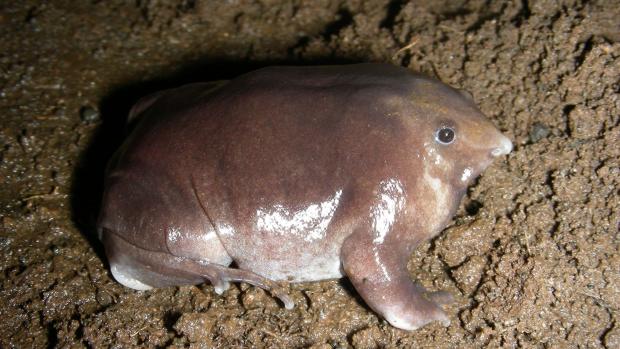
Photo : S. Jegath Janani
A new species of frog has been discovered in the Western Ghats, in India, thanks to a collaborative study by researchers - S. Jegath Janani, Karthikeyan Vasudevan and Ramesh K. Aggarwal from the Centre for Cellular and Molecular Biology (CCMB), Elizabeth Prendini from the American Museum of Natural History and Sushil Kumar Dutta from Nature Environment and Wildlife Society (NEWS). The species is named Nasikabatrachus bhupathi in memory of the late Dr. S. Bhupathy, a noted herpetologist, who met with a fatal accident while working on a research project in the Agasthyamalai hills of the Western Ghats on April 28, 2014. This paper was published on July 31, 2017 in Alytes, a scientific journal dedicated to publishing peer-reviewed articles on amphibians.
Measuring around 5 cm, N. bhupathi is a burrowing species which spends most of its life underground, only surfacing for a few days each year during the northeast monsoon, to mate. “Explosive breeding is a characteristic of the species. The males come close to the surface and call. They call in synchrony and the entire habitat echoes of the call, but you cannot spot the calling frog. They might even be calling from right under your feet and yet. It can be very difficult to trace them”, says Karthikeyan Vasudevan, Sr. Principal Scientist at CCMB.
The researchers came across the first adult specimen of the new species in 2012, at a farm near Srivilliputhur Grizzled Giant Squirrel Wildlife Sanctuary, after hearing them calling from the burrows beside the ephemeral streams. However, they had first detected distinct tadpoles of the Nasikabatrachus sp. two years earlier from streams flowing along the eastern slopes of the Western Ghats. “The first clue to this new species came from the DBT funded National initiative on ‘barcoding of anurans of India’. As part of that project we had collected some larvae and froglet samples that resembled those of the pignose frog, but when we barcoded them and compared them with those of our earlier described species, to our pleasant surprise, we realized that we had discovered a new member species of the monotypic family of the pignose frog” says Ramesh K. Aggarwal, Chief Scientist at CCMB.
N. bhupathi belongs to the genus Nasikabatrachus, of which there is only one other member, both of which are endemic to the Western Ghats. When its sister species, the purple frog, Nasikabatrachus sahyadrensis was discovered in 2003, it was hailed as a ‘once in a century find’. “With the addition of the new species, the two surviving species of frogs are relics of the ancient past, when our landmass broke away from Africa and proceeded to collide with Asia. The relatives of Nasikabatrachus are now surviving in Seychelles Island - another breakaway landmass of Gondwana”, adds Karthikeyan.
The new species, N. bhupathi was found to have different physical characteristics and calling pattern when compared to its sister species, N. sahyadrensis. The researchers also used molecular analysis to establish that the two species were genetically distinct. “The diversification of the two species of Nasikabatrachus is an example of external morphological stasis, which is generally observed in species occupying caves and subterranean biomes. Both taxa are subterranean species and do not show much difference in their external morphology except for skin coloration”, says Jegath Janani, from CCMB.
Interestingly, all the known records of the sister species, N. sahyadrensis are found along the western slopes of the Western Ghats, which receives more rainfall during the southwest monsoon, between June and September. On the other hand, the eastern slopes of the Western Ghats, where the new species are found, primarily receives rainfall during the northeast monsoon, between October and December. The study hypothesized that one of the reasons why they evolved to be a distinct species, could be because of a shift in their breeding times to different monsoon seasons. “Both have synchronized their breeding activity to the respective monsoons, and thereby have evolved into separate species”, says Karthikeyan.
Every new species discovery brings with it more questions waiting to be answered. “There are several unknowns in their life history: Where do they spend their time during the remainder of the year? How do they survive in low oxygen levels underground? How do they disperse and maintain their population?”, asks Karthikeyan.
Speaking about the discovery, Gururaja K V, a faculty at Srishti Institute of Art, Design and Technology and an Adjunct Scientist with Gubbi Labs, said "All these years we thought that it (N. sahyadrensis) is the only species in this genus. It took 14 years for another Nasikabatrachus species to be discovered. This shows that sampling has not been done thoroughly.” Could there be more unidentified species in this genus? “We may also have to survey in other parts of the Western Ghats in Tamil Nadu and Kerala. This must be coupled with systematic surveys. This is the need of the hour”, he signs off optimistically.





